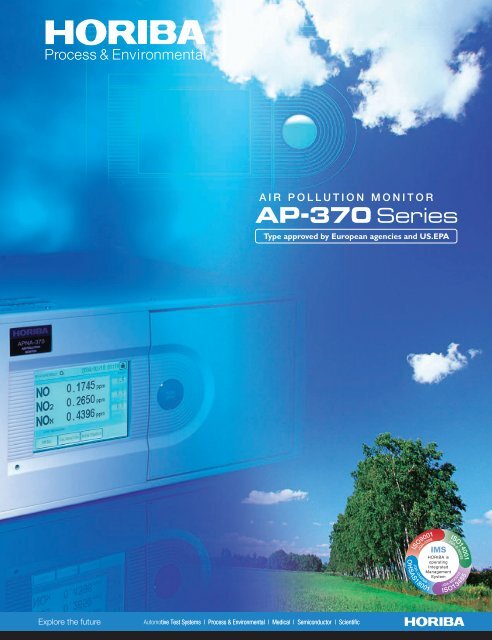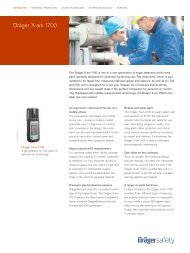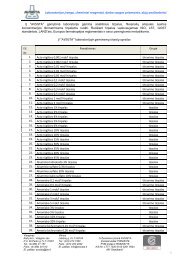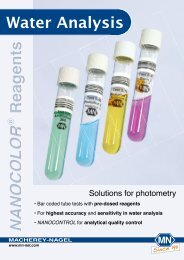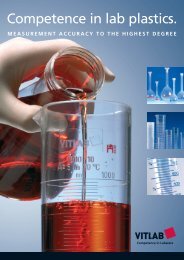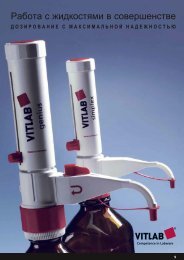AP-370 Series product literature - Horiba
AP-370 Series product literature - Horiba
AP-370 Series product literature - Horiba
Create successful ePaper yourself
Turn your PDF publications into a flip-book with our unique Google optimized e-Paper software.
Automatic calibration<br />
Auto-range function<br />
Selective data output<br />
Storing data in memory<br />
Network Communications (option)<br />
Troublesome calibration procedures have been reduced to<br />
the push of a function key. At the Auto-Interval Calibration<br />
(AIC) menu you can set the start time, the start range, and<br />
the interval for the automatic calibration. The system clock<br />
and calendar then assure that your calibration instructions<br />
are executed precisely. To make things even easier, remote<br />
auto-calibration can also be done from your own computer,<br />
via the monitor's RS-232C serial port (optional).<br />
An auto-range function that automatically switches to the<br />
range best suited to the object gas concentration for both<br />
momentary and average values is included as a standard<br />
feature. As an option, even when randomly set to any range<br />
(within 10 times the range ratio), the auto-range function<br />
can still be used. Switching over from auto-range to manualrange<br />
is a simple task.<br />
For each component measured, the system provides four<br />
types of data: momentary values, integrated values, moving<br />
averages, and simple averages. Any two these data may be<br />
output. Simultaneously to any two external devices. The<br />
time-span for both average and integrated values may be<br />
specified (i.e.,when the momentary value has not been<br />
selected). With the simple average values, three different<br />
timesettings can be specified.<br />
Four different values may be stored in memory: three simple<br />
averages and the integrated value.<br />
For example:<br />
Average value #1 (3 min)1,000 data sets<br />
Average value #2 (30 min)1,000 data sets<br />
Average value #3 (3 h)100 data sets<br />
Integrated value (1 h)1,000 data sets<br />
Serial communication is available through RS-232C serial<br />
port connected on the rear panel. The serial port makes<br />
analyzer data available using HORIBA's proprietary serial<br />
communication protocol, and can be easily converted to RS-<br />
485 for network data collection. Ethernet communication is<br />
available through an optional port using TCP/IP protocol.
AIR POLLUTION MONITOR<br />
Memory card for data management (option)<br />
Readout view, concentration and mass<br />
Pressure-compensation<br />
Easy-to-read, 320240 dot LCD<br />
display with touch panel screen.<br />
Minimal influence from interference<br />
components and ambient temperature<br />
Input/output via RS-232C port (option)<br />
At last----a small, compact system<br />
An available CompactFlash R (CF) can save average or<br />
integrated value, and read and collect data for off-line<br />
analysis.<br />
With the CF it is possible to conveniently use the analyzer<br />
in a stand-alone mode.<br />
The front panel can display the readout all that is needed<br />
concentration (ppm or ppb) and mass (mg/m 3 or μg/m 3 ).<br />
(Not available on Model <strong>AP</strong>HA-<strong>370</strong>, where CH4 values are<br />
displayed as ppm, NMHC and THC as ppmC.)<br />
Automatic compensation for ambient pressure assures<br />
reliable data regardless of the weather or the monitor's<br />
location.<br />
The adoption of full graphic LCD for the touch screen offers<br />
a large, easy-to-use display and user friendly, interactive<br />
operation. This user interface facilitates maintenance with<br />
displays such as the graph of lamp intensity (applicable for<br />
model <strong>AP</strong>OA-<strong>370</strong> and <strong>AP</strong>SA-<strong>370</strong> only), remaining time before<br />
replacement of pumps, valves, source lamp and converters. It<br />
also allows you to save average value, data, integrated value<br />
alarm history and calibration history.<br />
These monitors use <strong>Horiba</strong>'s innovative detection technology<br />
and sampling method for outstanding sensitivity. The<br />
influence from interference components is minimal and<br />
results are very stable over long periods of measurement.<br />
The system's RS-232C serial port can be used to transmit<br />
measured values, alarms, and other data to remote equipment.<br />
It can also be used to input changes to parameter<br />
settings and other data.<br />
A small, light-weight unit for each component to be measured<br />
fits neatly into a 19-inch rack. This makes it easy to<br />
up-grade your system in the future. This new design offers<br />
great savings in valuable lab space.<br />
CompactFlash R is a trademark of SANDISK CORPORATION
According to EN14626 and VDI 4202/4203<br />
TUEV Bericht 936/21204643B 05. Jan. 2006 U. S. EPA REFERENCE Equivalent Number RFCA-0506-158<br />
The cross flow modulation type, infrared-absorption technology eliminates<br />
the need for adjusting optical alignment.<br />
For the user, this means very stable and sensitive (5 ppm F.S.) measurements.<br />
The <strong>AP</strong>MA-<strong>370</strong> uses an AS type (antishock) interference-compensating detector, and a purified reference gas.<br />
The reference gas is generated by purging the sample through an oxidation process, where an oxidizing catalyst burns<br />
the CO to CO2. These features eliminate interference from other elements,<br />
resulting in highly accurate measurements.<br />
The <strong>AP</strong>MA-<strong>370</strong> does not use such components as reflecting mirrors, that attract foreign matter.<br />
This means the optical bench stays clean assuring you of stable results over long periods of time.<br />
Principle<br />
Cross flow modulation,<br />
Infrared (NDIR) absorption technology<br />
Conventional technology uses an optical chopper to<br />
obtain modulation signals. Instead, the <strong>AP</strong>MA-<strong>370</strong><br />
uses solenoid valve cross flow modulation. Fixed<br />
amounts of the sample gas and the reference gas<br />
are injected alternately into the measurement cell.<br />
With the cross flow-modulation method, if the same<br />
gas is used for both the sample gas and the reference<br />
gas (e.g., zero gas could be used for both), no<br />
modulation signal will be generated. This has the<br />
great advantage that, in principle, when analyzing<br />
minute amounts of gas there is no generation of<br />
zero-drift. An additional advantage is that the elimination<br />
of rotary sectors precludes the need for<br />
optical adjustment. These features assure greatly<br />
improved stability over long periods of measurement.<br />
A further improvement is that in the front chamber of<br />
the detector, the measurable components, including<br />
interference components, are detected; in the rear<br />
chamber, only interference components are detected.<br />
By means of subtraction processing, the actual<br />
signal obtained is one that has very little interference.<br />
Specifications<br />
Principle: Cross flow modulation, non-dispersive infrared (NDIR) absorption technology<br />
Application: CO in ambient air<br />
Range: Standard ranges: 0-10/20/50/100 ppm; 0-5/10/20/50 ppm; auto range manual range<br />
selectable; can be operated by remote switching.<br />
Optional (measurable) ranges: 4 ranges selectable from 0-100 ppm, within 10 times range<br />
ratio; auto range manual range selectable; can be operated by remote switching.<br />
Lower detectable limit: 0.02 ppm (3 sigma)<br />
Repeatability: 1.0% of F.S.<br />
Linearity: 1.0% of F.S.<br />
Zero drift: LDL/day at lowest range<br />
0.2 ppm/week at lowest range<br />
Span drift: LDL/day at lowest range<br />
1.0% F.S./week<br />
Response time (T90): Within 50 sec at lowest range<br />
Sample gas flow rate: Approx. 1.5L/min<br />
Indication: Measured value, range, alarm, maintenance screen<br />
Alarms: During AIC, zero calibration error, span calibration error, temperature error in catalyzer, etc.<br />
On-screen messages are available in four languages: English, German, French, and Japanese.<br />
Input/output:0-1 V/0-10 V/4-20 mA, to be specified (2 systems: either (1) momentary value and<br />
integrated or (2) moving average value) Contact input/output RS-232C (option)<br />
Ambient temperature: 5-40 <br />
Power: 100/110/115/120/220/230/240 VAC, 50/60 Hz (to be specified)<br />
Dimensions: 430(W)550(D)221(H) mm<br />
Mass: Approx. 16 kg,<br />
calibration<br />
zero gas<br />
inlet<br />
calibration<br />
span gas<br />
inlet<br />
capillary<br />
FS<br />
flow sensor<br />
pressure<br />
sensor<br />
<br />
PS<br />
sample<br />
inlet<br />
F<br />
filter<br />
<br />
MC<br />
analyzer<br />
FS<br />
flow sensor<br />
<br />
P<br />
pump<br />
exhaust<br />
CAT<br />
catalyzer<br />
F BT<br />
filter buffer tank
According to EN14212 and VDI 4202/4203<br />
TUEV Bericht 936/21204643D 07. Jul. 2006 U. S. EPA REFERENCE Equivalent Number EQSA-0506-159<br />
The <strong>AP</strong>SA-<strong>370</strong> uses an innovative detector and a new optical system for low background,<br />
high sensitivity (0.05 ppm F.S.), and greatly improved stability.<br />
The fluorescent chamber design gives measurements with minimum influence from moisture.<br />
The unit has built-in aromatic hydrocarbon cutter with a selective transmission membrane. This reduces the influence<br />
of interference components. Coupled with <strong>Horiba</strong>'s unique flow-path, it also makes it possible to extend the working<br />
life of the cutter and to take measurements effects of sample flow variations.<br />
In comparison with the FPD method, the <strong>AP</strong>SA-<strong>370</strong> design is (1) highly selective for SO2,<br />
(2) requires no supplemental gas, and (3) gives linear output.<br />
Compensation for the lamp's luminous energy decline guarantees prolonged calibration stability.<br />
The sample inlet has a built-in PTFE filter.<br />
Principle<br />
UV fluorescence<br />
The UV fluorescence method operates on the<br />
principle that when the SO2 molecules contained in<br />
the sample gas are excited by ultraviolet radiation<br />
they emit a characteristic fluorescence in the range<br />
of 220-420 nm. This fluorescence is measured and<br />
the SO2 concentration is obtained from changes in<br />
the intensity of the fluorescence.<br />
The reactive mechanism is<br />
(1) SO2+hSO2*<br />
(2) SO2*SO2+h<br />
(3) SO2*SO+(O)<br />
(4) SO2*+MSO2+M<br />
Here, (1) shows the excited state of the SO2 molecules<br />
that have absorbed the amount of energy h<br />
by ultraviolet radiation. (2) shows the amount of<br />
energy, h emitted by the excited molecules as they<br />
return to the ground state. (3) shows the decomposition<br />
by the light emitted from the excited molecules.<br />
(4) shows the quenching, i.e., the energy lost by the<br />
excited molecules colliding with other molecules.<br />
The <strong>AP</strong>SA-<strong>370</strong> uses an Xe lamp as the light source,<br />
and the fluorescent chamber design minimizes<br />
scattered light. The optical system has been carefully<br />
designed with low background light, making it<br />
possible to take measurements with a highly stable<br />
zero point. In addition, a reference detector<br />
monitors any fluctuation in the intensity of the light<br />
source. This allows the unit to calibrate itself<br />
automatically for sensitivity, resulting in greater<br />
span stability.<br />
Specifications<br />
Principle: UV fluorescence (UVF)<br />
Application: SO2 in ambient air<br />
Range: Standard ranges: 0-0.05/0.1/0.2/0.5 ppm; auto range manual range selectable; can be<br />
operated by remote switching.<br />
Optional (measurable) ranges: 4 ranges selectable from 0-10 ppm, within 10 times range ratio;<br />
auto range manual range selectable; can be operated by remote switching.<br />
Lower detectable limit: 0.5 ppb(3 sigma)<br />
Repeatability: 1.0% of F.S.<br />
Linearity: 1.0% of F.S.<br />
Zero drift: LDL/day at lowest range<br />
LDL/week at lowest range<br />
Span drift: LDL/day at lowest range<br />
LDL/week at lowest range<br />
Response time (T90): Within 120 sec at lowest range<br />
Sample gas flow rate: Approx. 0.7L/min<br />
Indication: Measured value, range, alarm, maintenance screen<br />
Alarms: During AIC, zero calibration error, span calibration error, temperature error in catalyzer, etc.<br />
On-screen messages are available in four languages: English, German, French, and Japanese.<br />
Input/output:0-1 V/0-10 V/4-20 mA, to be specified (2 systems: either (1) momentary value and<br />
integrated or (2) moving average value) Contact input/output RS-232C (option)<br />
Ambient temperature: 5-40 <br />
Power: 100/110/115/120/220/230/240 VAC, 50/60 Hz (to be specified)<br />
Dimensions: 430(W)550(D)221(H) mm<br />
Mass: Approx. 19 kg,<br />
sample<br />
inlet<br />
calibration gas<br />
inlet<br />
F<br />
filter<br />
solenoid valve<br />
cutter<br />
analyzer unit<br />
FS<br />
flow sensor<br />
orifice<br />
pressure<br />
sensor<br />
PS<br />
P<br />
P<br />
pump<br />
exhaust<br />
F<br />
capillary<br />
SCR<br />
scrubber
According to EN14211 and VDI 4202/4203<br />
TUEV Bericht 936/21204643C 07. Jul. 2006 U. S. EPA REFERENCE Equivalent Number RFNA-0506-157<br />
The <strong>AP</strong>NA-<strong>370</strong> uses a combination of the dual cross flow modulation type chemiluminescence principle<br />
and the referential calculation method.<br />
This gives it the advantages of the single-detector method plus the ability to do continuous measurements of NOx, NO,<br />
and NO2. The design gives great stability and extremely high sensitivity (0.1 ppm F.S.)<br />
Standard equipment includes a drier unit with an automatic recycle function to provide dry ambient air<br />
as the ozone source. This makes long-term continuous measurements possible.<br />
The detector uses a silicon photodiode sensor to reduce size and prolong working life.<br />
All the necessary features are built right into a single rack-sized unit, including a reference-gas generator,<br />
an ozone-source drier unit, an ozone decomposer, and a sampling pump. No supplemental gas is required.<br />
Principle<br />
Cross flow modulation type, reduced<br />
pressure chemiluminescence (CLD)<br />
The chemiluminescence method uses the reaction<br />
of NO with O3<br />
NO+O3NO2*+O2<br />
NO2+NO2+h<br />
A portion of the NO2 generated as the result of this<br />
reaction becomes NO2*. As these excited molecules<br />
return to the ground state, chemiluminescence is<br />
generated in the range of 600 nm to 3,000 nm. The<br />
light intensity is in proportion to the concentration of<br />
NO molecules and by measuring it we obtain the NO<br />
concentration of the sample. A deoxidation converter<br />
changes the NO2 to NO, which is measured. In<br />
other words, the NO2 concentration can be obtained<br />
by the difference between (1) the NOx concentration<br />
measured when the sample gas is directed through<br />
a converter and (2) the NO concentration measured<br />
when the gas is not run through the converter.<br />
Specifications<br />
Principle: Cross flow modulation type, reduced pressure chemiluminescence (CLD)<br />
Application: NO2, NO and NOx in ambient air<br />
Range: Standard ranges: 0-0.1/0.2/0.5/1.0 ppm; auto range manual range selectable;<br />
can be operated by remote switching.<br />
Optional (measurable) ranges: 4 ranges selectable from 0-10 ppm, within 10 times range ratio;<br />
auto range manual range selectable; can be operated by remote switching.<br />
Lower detectable limit: 0.5 ppb(3 sigma)<br />
Repeatability: 1.0% of F.S.<br />
Linearity: 1.0% of F.S.<br />
Zero drift: /day, at lowest range<br />
1.0 ppb/week at lowest range<br />
Span drift: /day at lowest range<br />
1.5 % of F.S./week<br />
Response time (T90): Within 90 sec at lowest range<br />
Sample gas flow rate: Approx. 0.8L/min<br />
Indication: Measured value, range, alarm, maintenance screen<br />
Alarms: During AIC, zero calibration error, span calibration error, temperature error in converter, etc.<br />
On-screen messages are available in four languages: English, German, French, and Japanese.<br />
Input/output:0-1 V/0-10 V/4-20 mA, to be specified (2 systems: either (1) momentary value and<br />
integrated or (2) moving average value) Contact input/output RS-232C (option)<br />
Ambient temperature: 5-40 <br />
Power: 100/110/115/120/220/230/240 VAC, 50/60 Hz (to be specified)<br />
Dimensions: 430(W)550(D)221(H) mm<br />
Mass: Approx. 21 kg,<br />
F<br />
filter<br />
pump<br />
P<br />
check valve<br />
solenoid<br />
valve<br />
capillary<br />
dryer<br />
F D F OGU<br />
filter filter<br />
ozonator<br />
unit<br />
capillary<br />
F D F<br />
regulator<br />
calibration<br />
gas inlet<br />
sample inlet<br />
F<br />
COM<br />
Permeation converter<br />
drier unit<br />
capillary<br />
solenoid valve<br />
analyzer<br />
deozonizer<br />
DO F FS<br />
regulator<br />
buffer tank<br />
BT<br />
MC<br />
PS<br />
flow sensor mist<br />
pressure catcher<br />
sensor<br />
P<br />
exhaust<br />
option
The <strong>AP</strong>HA-<strong>370</strong> uses a combination of the flame ionization detection method and selective-combustion.<br />
This gives it the advantage of the single-detector method plus the ability to perform continuous measurements,<br />
free of zero-drift, for THC, NMHC, and CH4. The design gives great stability and high sensitivity (0-5 ppm F.S.)<br />
The <strong>AP</strong>HA-<strong>370</strong> has a relative-sensitivity correction function for CH4 and NMHC.<br />
All the necessary features are built right into a single rack-sized instrument, including a catalytic unit<br />
for selective combustion (i.e., an NMHC cutter); a catalytic unit for generating reference gas and auxiliary<br />
combustion air (standard); and a sampling pump. The only supplemental gas required is H2.<br />
Principle<br />
Flame ionization detection method (FID)<br />
with selective-combustion<br />
The flame ionization detection method (FID) used<br />
in combination with the selective-combustion<br />
system utilizes the ionization that occurs as the<br />
result of the high-temperature energy from combustion<br />
at the tip of the burner jet when organic carbon<br />
compounds are introduced into the hydrogen flame.<br />
The hydrogen flame is located between two electrodes.<br />
When an electrical voltage is applied across these<br />
electrodes a minute ion current proportional to the<br />
hydrocarbon concentration is produced. This<br />
current is monitored by a low leakage amplifier,<br />
giving a voltage readout for THC. To measure CH4<br />
the sample gas is passed through the selective<br />
catalytic combustion unit (the NMHC cutter), which<br />
oxidizes NMHC without oxidizing CH4. This is shown<br />
as A below. B represents the THC concentration<br />
measured without passing the gas through the<br />
NMHC cutter. Thus B- A will give the concentration<br />
of NMHC. The final concentration value is calculated<br />
using a relative-sensitivity correction coefficient, k,<br />
as shown below.<br />
CH4 Concentration A<br />
NMHC Concentration k (B - A)<br />
THC Concentration A + k (B - A)<br />
Specifications<br />
Principle: Flame ionization detection (FID) with selective combustion<br />
Application: THC, NMHC, and CH4 in ambient air<br />
Range: Standard ranges: 0-5/10/20/50 ppmC; auto range manual range selectable; can be<br />
operated by remote switching.<br />
Optional (measurable) ranges: 4 ranges selectable from 0-100 ppmC, within 10 times range ratio;<br />
auto range manual range selectable; can be operated by remote switching.<br />
Lower detectable limit: 0.022 ppmC(3 sigma)<br />
Repeatability: 1.0% of F.S.<br />
Linearity: 1.0% of F.S.<br />
Zero drift: /day at lowest range<br />
0.05 ppmC/week at lowest range<br />
Span drift: /day at lowest range<br />
0.5 % F.S./week<br />
Response time (T90): Within 60 sec at lowest range<br />
Sample gas flow rate: Approx. 0.9 L/min<br />
Indication: Measured value, range, alarm, maintenance screen<br />
Alarms: During AIC, zero calibration error, span calibration error, temperature error in zero gas purifier, ignition failure error, etc.<br />
On-screen messages are available in four languages: English, German, French, and Japanese.<br />
Input/output:0-1 V/0-10 V/4-20 mA, to be specified (2 systems: either (1) momentary value and<br />
integrated or (2) moving average value) Contact input/output RS-232C (option)<br />
Ambient temperature: 5-40 <br />
Power: 100/110/115/120/220/230/240 VAC, 50/60 Hz (to be specified)<br />
Dimensions: 430(W)550(D)221(H) mm<br />
Mass: Approx. 33 kg,<br />
Notes: ppmC is shown as symbol, not as unit.<br />
fuel(H2) inlet<br />
calibration<br />
zero gas inlet<br />
calibration<br />
span gas inlet<br />
sample inlet<br />
F<br />
filter<br />
FS<br />
dummy<br />
DUM<br />
non-methan cutter<br />
NMC<br />
solenoid valve<br />
CF<br />
pressure<br />
regulator charcoal<br />
filter<br />
solenoid valve<br />
F<br />
capillary<br />
FS<br />
F<br />
buffer tank<br />
BT<br />
vacuum regulator<br />
P<br />
pump<br />
differrential regulator<br />
exhaust<br />
PUR<br />
F<br />
BT<br />
zero gas<br />
purifier<br />
analyzer<br />
dryer<br />
F D F<br />
PS<br />
pressure<br />
sensor<br />
solenoid<br />
valve<br />
check<br />
valve<br />
option<br />
F D F<br />
PS
According to EN14625 and VDI 4202/4203<br />
TUEV Bericht 936/21204643A 05. Jan. 2006 U. S. EPA REFERENCE Equivalent Number EQOA-0506-160<br />
The <strong>AP</strong>OA-<strong>370</strong> uses the cross flow modulation type, ultra-violet absorption method in conjunction<br />
with the comparative calculation method.<br />
This permits continuous measurement with great stability and high sensitivity (0.1 ppm F.S.)<br />
<strong>Horiba</strong>'s innovative heated deozonizer provides reference gas by decomposing the O3 found in the sample gas.<br />
This has the advantages of (1) reducing the influence from interference, (2) making the monitor insensitive<br />
to great changes in moisture content, and (3) prolonging the working life of the monitor.<br />
All gas connections are either PTFE or glass.<br />
Principle<br />
Cross flow modulation type,<br />
Non dispersive ultra-violet absorption<br />
method (NDUV)<br />
The ultra-violet absorption method works on the principle<br />
that ozone absorbs ultra-violet rays in the<br />
area of 254 nm. Measurements are taken from continuous,<br />
alternate injections of the sample gas and<br />
the reference gas into the measurement cell,<br />
controlled by a long-life solenoid valve. The cross<br />
flow modulation method is characteristically zerodrift<br />
free. A comparative calculation circuit<br />
automatically compensates for all fluctuations in the<br />
mercury vapor light source and in the detector. This<br />
means that, in principle, the <strong>AP</strong>OA-<strong>370</strong> makes it<br />
possible to carry out zero-span drift free, continuous<br />
measurements. In addition, HORIBA'S unique deozonizer<br />
for the comparison gas line is unaffected<br />
by interference elements or moisture retention,<br />
prolonged, stable measurement is possible.<br />
Specifications<br />
Principle: Cross flow modulation type, Ultra-violet-absorption method (NDUV)<br />
Application: O3 in ambient air<br />
Range: Standard ranges: 0-0.1/0.2/0.5/1.0 ppm; auto range manual range selectable;<br />
can be operated by remote switching.<br />
Optional (measurable) ranges: 4 ranges selectable from 0-10 ppm, within 10 times range ratio;<br />
auto range manual range selectable; can be operated by remote switching.<br />
Lower detectable limit: 0.5 ppb(3 sigma)<br />
Repeatability: 1.0% of F.S.<br />
Linearity: 1.0% of F.S.<br />
Zero drift: /day at lowest range<br />
/week at lowest range<br />
Span drift: /day at lowest range<br />
/week at lowest range<br />
Resposnse time (T90): Within 75 sec at lowest range<br />
Sample gas flow rate: Approx. 0.7 L/min<br />
Indication: Measured value, range, alarm, maintenance screen<br />
Alarms: During AIC, zero calibration error, span calibration error, temperature error in ozone separator,<br />
light intensity error, etc.<br />
On-screen messages are available in four languages: English, German, French, and Japanese.<br />
Input/output:0-1 V/0-10 V/4-20 mA, to be specified (2 systems: either (1) momentary value and<br />
integrated or (2) moving average value) Contact input/output RS-232C (option)<br />
Ambient temperature: 5-40 <br />
Power: 100/110/115/120/220/230/240 VAC, 50/60 Hz (to be specified)<br />
Dimensions: 430(W)550(D)221(H) mm<br />
Mass: Approx. 15 kg,<br />
pressure<br />
sensor<br />
solenoid valve<br />
PS<br />
sample gas<br />
inlet<br />
F<br />
FS<br />
P<br />
exhaust<br />
filter<br />
DO<br />
analyzer<br />
flow sensor<br />
<br />
pump<br />
deozonizer<br />
calibration<br />
gas inlet<br />
option
H2S/TRS Measurement<br />
Calibration Equipment<br />
FeaturesPrinciple<br />
Combined use of the H2S converter unit and the <strong>AP</strong>SA: SO2 Monitor makes<br />
H2S measurement possible. The H2S converter unit contains two types of<br />
catalyst: SOx scrubber and H2S converter. SOx is removed by the SOx<br />
scrubber, and then the H2S that has passed through is converted into SO2<br />
by the H2S converter. This SO2 is then measured by the <strong>AP</strong>SA: SO2 Monitor<br />
for display as H2S concentration.<br />
Specifications<br />
Range: 0.1-0.1/0.2/0.5/1.0 ppm<br />
Power: 100/110/115/120/220/230/240 VAC, 50/60 Hz<br />
Dimensions: CU-1: 430(W)550(D)221(H) mm<br />
<strong>AP</strong>SA: 430(W)550(D)221(H) mm<br />
Mass: CU-1: Approx. 10 kg<br />
<strong>AP</strong>SA: Approx. 25 kg<br />
HORIBA offers various calibration <strong>product</strong>s for optional use with the <strong>AP</strong>-<strong>370</strong>.<br />
HORIBA's calibration equipment support mainly the following methods:<br />
Option<br />
Internal or external permeation device<br />
for SO2, H2S, BTX, NO2 and many more<br />
External gas phase titration for NO/NO2<br />
Ozone generation with an internal or<br />
external O3 generator based on UV radiation<br />
All calibrators can be equipped with thermal mass flow controllers or pressure<br />
regulators and capillaries depending on the precision requirements.<br />
Stationary and portable single components as well as multi-component<br />
calibrators are available upon client's specification. Corresponding<br />
interfaces as well as calibration and QC protocols can also be supplied.<br />
NH3 Measurement<br />
Digital Calibrator<br />
FeaturesPrinciple<br />
Combined use of the NH3 converter unit and the <strong>AP</strong>NA: NOx Monitor<br />
makes NH3 measurement possible. The NH3 converter unit contains two<br />
types of catalyst tubes: one which converts NH3 into NOx, and one which<br />
allows the NOx in the ambient air to pass through directly. The difference<br />
in NOx value between the two is measured by the <strong>AP</strong>NA: NOx Monitor for<br />
display as NH3 concentration.<br />
Specifications<br />
Range: 0-1/2/5-10 ppm<br />
Power: 100/110/115/120/220/230/240 VAC, 50/60 Hz<br />
Dimensions: CU-2: 430(W)550(D)310(H) mm<br />
<strong>AP</strong>NA: 430(W)550(D)221(H) mm<br />
Mass: CU-2: Approx. 20 kg<br />
<strong>AP</strong>NA: Approx. 26 kg<br />
Features<br />
HORIBA's MCC-1000 is designed to calibrate gas analyzers manually,<br />
remotely controlled or automatically, installed in air pollution monitoring<br />
stations, for quality assurance in the laboratory and also for the<br />
<strong>product</strong>ion of gas analyzers.<br />
A special feature of HORIBA's MCC-1000 is the easily-to-read touch<br />
screen panel, for ease of operation. Characteristic of operation of<br />
HORIBA's MCC-1000 is the intuitive, simple and user friendly menu. (Flow<br />
rate, mg/m 3 , ppb/ppm, automatic cycles etc.) Via the touch screen, it is<br />
possible to enter span gas concentrations or to start autmatic routines like<br />
multi point calibration cycles.<br />
Specifications<br />
Principle: Dynamic generation of zero and span gas with<br />
mass flow controllers<br />
Mass Flow Controller (MFC): supports multi-point calibration<br />
Power: 230 VAC , 50 Hz (other on request), 50 VA<br />
Dimensions: 430(W)400(D)120(H) mm (19") with brackets<br />
Mass: Approx. 10 kg
Intelligent Data Acquisition System<br />
HORIBA IDA-2000<br />
HORIBA’s IDA-2000 is an intelligent data acquisition<br />
system (DAS) using a desktop or industrial PC,<br />
designed for fully automatic monitoring stations.<br />
The entire data capture and mean value calculation<br />
as well as control of the analyzers is executed by 32<br />
bit multitasking software, running in a state-of-theart<br />
Windows environment. It combines the power<br />
of a workstation with the ease of use, compatibility<br />
and <strong>product</strong>ivity of a personal computer. The<br />
measured values as well as operating and error<br />
status messages are gathered in a 5-second<br />
interval from the analyzers. They are converted into<br />
engineering units, checked for plausibility and<br />
synchronously converted into two different<br />
averages. Automatic calibration routines in<br />
predefined intervals can be started either from the<br />
station computer or through a remote host<br />
computer. The DAS also supports the manual<br />
execution of calibration sequences as well as<br />
remote maintenance operations.<br />
Bar graph of actual values<br />
Graphic presentation of 2nd mean values<br />
Tabular report of 2nd mean values<br />
Wind rose<br />
Data Management and Reporting Software<br />
HORIBA IDA-ZRW<br />
HORIBA’s IDA-ZRW is a data management and reporting<br />
software for use in Ambient Air Quality and<br />
Meteorological monitoring. The software package<br />
provides data collection, management, analysis and<br />
reporting. Measured data and related information is<br />
stored in a high-end relational SQL database. The<br />
software can be used stand-alone or run on several<br />
machines in a network environment operating in<br />
Microsoft Windows environments. Communication<br />
between Central & Remote Stations works with a<br />
wide variety of communication links, such as direct<br />
connections, short-haul modems, telephone (including<br />
cellular) and multi-drop. Data can be transferred<br />
to and presented in Internet pages according to<br />
customers requirements.<br />
Report preview<br />
3D-column chart of 3h-means<br />
Example of various reports<br />
DCS main<br />
Quick look<br />
Quick look
Complete Integrated System<br />
HORIBA designs, assembles, calibrates and tests<br />
complete integrated systems for simultaneously<br />
measuring multiple pollutants. A system for monitoring<br />
five pollutants can typically fit into one 19-inch<br />
rack. Rack-mounted systems can be installed in<br />
equipment rooms, stand-alone shelters, trailers,<br />
vans, large trucks, or aboard marine vessels.<br />
HORIBA can integrate <strong>product</strong>s into existing<br />
monitoring systems, or design and build a new<br />
system.<br />
South african bureau of standards<br />
Various Types of Fixed Stations and Mobile Laboratories<br />
HORIBA designs and builds complete solutions precisely tailored to customer’s requirements<br />
Fixed monitoring stations for continuously measuring air pollutants<br />
Reykjavik environment / Iceland<br />
Agency for environmental Federal State of Bavaria<br />
Mobile laboratory with detachable shelter<br />
Mobile laboratories to investigate the geographic distribution of air pollution<br />
Mobile Laboratory<br />
These vans and trucks are just some of the<br />
projects weÕve done for customers in Europe<br />
Professional association for civil engineering
Standard 19-inch Packages<br />
Each HORIBA <strong>AP</strong>-<strong>370</strong> <strong>Series</strong> Monitor is packaged in a light metal enclosure with sliding chassis suitable<br />
for either a table-top set-up in a research laboratory or mounting on a standard 19-inch rack for permanent installation.<br />
All the controls and serviceable components are accessible from the front for easy maintenance<br />
while the plumbing and cable connections are neatly arranged at the back.<br />
Dimensional Outline <br />
<br />
<br />
<br />
<br />
<br />
<br />
HORIBA continues contributing<br />
to the preservation of the global<br />
environment through analysis<br />
and measuring technology.<br />
Please read the operation manual before using this <strong>product</strong> to assure safe and proper handling of the <strong>product</strong>.<br />
●The contents of this catalog are subject to change without prior notice, and without any subsequent liability to this company.<br />
●The color of the actual <strong>product</strong>s may differ from the color pictured in this catalog due to printing limitations.<br />
●It is strictly forbidden to copy the content of this catalog in part or in full.<br />
●All brand names, <strong>product</strong> names and service names in this catalog are trademarks or registered trademarks of their respective companies.<br />
http://www.horiba.com<br />
e-mail: info@horiba.co.jp<br />
●HORIBA, Ltd.<br />
Head Office<br />
2 Miyanohigashi, Kisshoin<br />
Minami-ku, Kyoto, Japan<br />
Phone: 81 (75) 313-8123<br />
Fax: 81 (75) 321-5725<br />
●HORIBA INSTRUMENTS<br />
Pte. LTD.<br />
10 Ubi Crescent<br />
#05-11/12, Ubi Techpark<br />
Singapore 408564<br />
Phone: 65 6745-8300<br />
Fax: 65 6745-8155<br />
●HORIBA GmbH<br />
Kaplanstrasse 5<br />
A-3430 Tulln,<br />
Austria<br />
Phone: 43 (2272) 65225<br />
Fax: 43 (2272) 65230<br />
Bulletin:HRE-2858E<br />
Tokyo Sales Office<br />
1-7-8 Higashi-Kanda<br />
Chiyoda-ku, Tokyo, Japan<br />
Phone: 81 (3) 3861-8231<br />
Fax: 81 (3) 3861-8259<br />
HORIBA CZECHIA<br />
Organizachi slozka Praha<br />
Petrohradska 13<br />
CZ-101 00 Praha 10,<br />
Czech Republic<br />
Phone: 420 (2) 717-464-80<br />
Fax: 420 (2) 717-470-64<br />
●HORIBA TRADING (SHANGHAI) CO., Ltd.<br />
Shanghai Office<br />
Room 1701, United Plaza,<br />
1468 Nanjing Rd. West,<br />
Shanghai, 200040, China<br />
Phone: 21-6289-6060<br />
Fax: 21-6289-5553<br />
●HORIBA India Private Limited<br />
Delhi Office<br />
Pune Office<br />
1212A, Hemkunt Tower, 502, Purushottam Plaza,<br />
98 NehruPlace,<br />
Baner Road, Baner,<br />
New Delhi - 110019 INDIA Pune - 411045 INDIA<br />
Phone: +91 11-4669-5001/5002 Phone: +91 20-2729-1121<br />
●HORIBA EUROPE GmbH<br />
Head Office<br />
Hans-Mess-Str.6<br />
D-61440 Oberursel/Ts.<br />
Germany<br />
Phone: 49 (6172) 1396-0<br />
Fax: 49 (6172) 137385<br />
Beijing Office<br />
Room 1801, Capital Tower Beijing,<br />
Tower 1 No.6Jia, Jianguomenwai Ave.,<br />
Chaoyang District, Beijing,<br />
100022 China<br />
Phone: 10-8567-9966<br />
Fax: 10-8567-9066<br />
●HORIBA INSTRUMENTS<br />
INCORPORATED<br />
Irvine Facility<br />
17671 Armstrong Avenue<br />
Irvine, CA 92614, U.S.A.<br />
Phone: 1 (949) 250-4811<br />
Fax: 1 (949) 250-0924<br />
Leichlingen Facility<br />
Julius-kronenberg Strasse<br />
D-42799 Leichlingen<br />
Germany<br />
Phone: 49 (2175) 8978-0<br />
Fax: 49 (2175) 8978-50<br />
●HORIBA KOREA L t d .<br />
112-6 Sogong-Dong<br />
Choong-ku, Seoul, Korea<br />
Phone: 82 (2) 753-7911<br />
Fax: 82 (2) 756-4972<br />
●HORIBA INSTRUMENTS<br />
LIMITED<br />
Kyoto Close<br />
Summerhouse Road<br />
Moulton Park, Northampton<br />
NN3 6FL, U.K.<br />
Phone: 44 (1604) 542500<br />
Fax: 44 (1604) 542699<br />
●HORIBA FRANCE<br />
12, Avenue des Tropiques<br />
91955 LES ULIS<br />
France<br />
Phone: 33 (1) 69-29-96-23<br />
Fax: 33 (1) 69-29-95-77<br />
Printed in Japan T-K(SK)53


